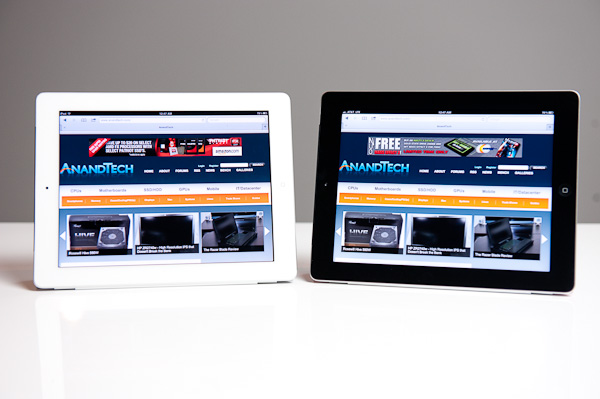The Apple iPad Review (2012)
by Vivek Gowri & Anand Lal Shimpi on March 28, 2012 3:14 PM ESTSince Apple launched the first iPad two years ago, the tablet market has evolved rapidly. While slate tablets were nothing new, the original iPad was the first serious tablet to be built around smartphone components and a user interface designed specifically for touchscreen input. The hardware was enough to run the OS smoothly while maintaining good battery life, the thin and light form factor lent itself to easy portability, and the touch-based user experience was miles better than earlier devices based on desktop operating systems.
We take it for granted now, but this was all news back in 2010, and the iPad was practically in a category of its own, with no real competitors to speak of. After Apple started shipping the iPad, the segment basically exploded—we had Google jump in with Honeycomb, HP got into it (and then out of it) with webOS, RIM had a go with the PlayBook, Amazon pushed the Kindle line into the tablet space, and Microsoft created its next release of Windows with tablets in mind. Along the way, Apple updated the iPad, both on the software side with multitasking, a new notifications system, and a myriad of UI updates, as well as launching second generation iPad hardware. The iPad 2 was a comprehensive update, bringing a dual core processor, unrivaled graphics performance, cameras fore and aft, and a ground up redesign that brought a thinner and lighter form factor.
The iPad 2 was a significant improvement over the original—faster, more portable, and generally a far more polished device. Not that it was perfect: iOS 4 still had issues with smooth multitasking and an archaic notifications system, the cameras were mediocre, and the XGA display, while a great quality panel, didn’t have the kind of pixel density expected of a premium mobile device. The iPad 2 hit market around the same time as Honeycomb (in Motorola’s Xoom) early last year, and at first Apple still held a major edge in terms of hardware. As more impressive Honeycomb devices like Samsung’s Galaxy Tab 10.1 and the ASUS Transformer Prime were launched, along with Ice Cream Sandwich looming on the horizon, Android became a much more viable tablet alternative to iOS. And with Microsoft planning for a major push later this year for ARM-based Windows 8 tablets centered around the Metro UI, Apple has never faced such stiff competition in the tablet space. Which brings us to the third generation of iPad hardware.
It has a display resolution that dwarfs most high-end desktop displays. The panel also puts a real emphasis on quality, not just resolution. For a computing device targeted squarely at the consumer market, both of these things are rarities.
Its SoC is the absolute largest ever squeezed into an ARM based tablet. The chip itself is even bigger than what you find in most mainstream notebooks. It’s expensive, it puts out a ton of heat and it offers a tremendous GPU performance advantage over anything else in its class.
And it has a battery that’s larger than what ships in the current crop of similarly sized ultraportables and Ultrabooks.
The new iPad doesn’t significantly change the tablet usage paradigm, but it does put all previous attempts at building hardware in this space to shame. It’s the sort of no holds barred, performance at any expense design that we’re used to seeing from enthusiast PC component vendors—but in a tablet...from Apple.
Welcome to the new iPad.












234 Comments
View All Comments
PeteH - Wednesday, March 28, 2012 - link
No idea. Was it necessary to upgrade the GPU to get an equivalent experience on the larger screen in that case, or was performance on the 3GS limited by the CPU (or RAM, or something else)?zorxd - Thursday, March 29, 2012 - link
just look at benchmarks on this web siteThe iPhone 3GS gets more FPS in 3D games because of the lower resolution.
So in short, yes, it would have been necessary to upgrade the GPU to keep the same performance.
But no matter what Apple does, people will always say it's the right choice.
PeteH - Thursday, March 29, 2012 - link
I looked for a comparison between 3GS and 4 game FPS comparison and couldn't find anything. Can you point me to it?I'm looking for hard numbers because just increasing the resolution doesn't necessarily mean a GPU upgrade is necessary. If (and this is completely hypothetical) the 3GS was performance limited because of its CPU, improving the CPU in the 4 could allow it to achieve the same performance at a higher resolution.
I'm not remotely saying this is the case, just that I've seen no numbers demonstrating a drop in frame rate from the 3GS to the 4.
dagamer34 - Friday, March 30, 2012 - link
I believe the GPU got a clock speed increase when it went from the 3GS to the 4.Peter_St - Monday, April 2, 2012 - link
Oh wait, let me rephrase this: I have this nice shiny tower with 2GB of RAM and newest CPU out there but shitty OS with java hogs and memory leaks, but who cares, I'll just go and jerk off on the specs.I think that's what you wanted to say...
tipoo - Wednesday, March 28, 2012 - link
GPUs which consume hundreds of times more watts than SoCs like this and have much more memory bandwidth at their disposal still struggle with the resolution this thing is displaying. The Xbox 360 GPU has, if I recall, around 25GB/s vs 6 in this, and that struggles to run games at 720p in a constant 30FPS. So far, it seems like the retina compatible games do display at native res, but there aren't any improvements in textures, effects, etc. So would the additional GPU power effectively be negated by the resolution for native apps, and still be constrained to games that look straight out of 2003-4? Or is Imagination Tech's video memory compression that much more advanced than AMDs/Nvidias so bandwidth doesn't matter as much?zorxd - Wednesday, March 28, 2012 - link
It's not only about the resolution. You could probably play Doom just fine with the SGX543MP4 at this resolution. The problem is when you have more complex level of details, shaders, etc. The iPad couldn't play a game like Crysis even at half resolution. But even at 2048x1536, Doom will still look like a game of the 90s.tipoo - Wednesday, March 28, 2012 - link
*12.8GB/s, my mistakeBSMonitor - Wednesday, March 28, 2012 - link
What's battery life watching a bunch of movies.. say from New York to Hawaii? Will I be able to get 9 hours??Can run all the compute benchies we want, but primarily these are portable entertainment devices. The simplest use being the most common.
PeteH - Wednesday, March 28, 2012 - link
Depends how bright you want the display, but from the number they're posting you should be fine at < 70% max brightness.I would argue that the most common use case is probably web browsing though, not movie watching. Unless... how often are you on these flights from New York to Hawaii?